With each years we gain experience and make some changes to refine our Compac, Remote Access, to be better fit our needs. Our usage so far has been mostly day sailing in an area that often has strong winds, and some light to moderate coastal cruising. Our intent (less Tara's intent than mine) is to gradually move to more serious coastal cruising.
Our impression of the Compac 23/3 is shaped by the sailing conditions in which we sail. We sail in more moderate to strong conditions than light. Overall, we are very pleased with the decision to go with a Compac 23/3. It is an excellent small boat.
Note: For section titles which are highlighted click on the section title for further information.
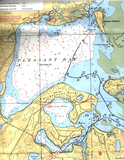
We've sailed Remote Access in conditions ranging from almost imperceptible breeze to over 30 knots. Most of our sailing is done in 10-20 knots. It is unusaul for the winds in Pleasant Bay or in the Atlantic off Outer Cape Cod to be much under 10 knots in July, though 5-10 is not uncommon in August. Under 5 knots is unusual except well after sunset up to sunrise.
Unless sailing days are limited to only those days in which fair weather is virtually guarenteed, getting stuck in a near gale or gale is almost inevitable. So far we've been lucky and only encountered strong conditions on our own terms, in the safety of Pleasant Bay. Local weather predictions frequently call for fair weather with a small probability of scattered thundershowers. Thundershowers in this area can bring near-gail or gail force squals. Sooner or later we'll get caught out on the ocean in strong conditions, but we've been careful and it hasn't happenned yet. Better to be prepared.
In our first season we had one day in which wind was reported to be over 30 knots. Remote Access was very difficult to handle under single reef mainsail only on any point of sail and near impossible on some. The single reef proved inadequate. The lack of a boom vang made downwind sailing difficult due to the boom rising uncontrollably. We were carrying a 150% genoa that first year.
We've made a great deal of progress. At this point 25 knots is easy to sail in. The single reef has proven adequate with the 110% genoa furled a bit at near 25 knots, but a rough ride. The second reef makes for relatively comfortable sailing at 25 knots. Our remaining sail reduction is the 60% jib which we have yet to sail with.
We have so far sailed in up to 20-25 knots with gusts to 35 knots and numberous times in steady 25 knots. In the 35 knot gusts the second reef was in and a few rolls were taken on the 110% headsail. The 60% sail would have been useful if those gusts were sustained and would be needed for any extended sailing in those conditions. In steady 25 knots we have sailed both with the single reef in the main and the second reef in the main. With the second reef in the main we can sail with the full 110% jib out which seems to be a better combination.
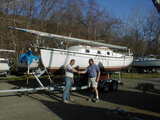
We were looking for was a small seaworthy cruiser with a shallow draft. Overall we're very pleased with the Compac 23/3 and the people we've dealt with when we purchased and since then. Some of the stock equipment is not well suited for the conditions that we found ourselves sailing in so we had to make some changes. Further changes are planned. This is to be expected.
The most significant shortcomings in the Compac 23/3 as initially equipt were in the selection of sails, the roller furler, and the sail handling and sail controls. For those who will not be sailing in winds over 15-20 knots they are probably adequate as is but could still stand some improvement. For sailing in 25 knots and above they were inadequate.

By far the biggest mismatch between the boats equipment and the sailing we are doing was the headsail. We sailed our entire first season with the 150% genoa that came with the boat. It was absolutely the wrong sail to be caryying for the conditions where we sail. At the end of the season we had the genoa recut smaller.
The genoa recut was a considerable improvement but led to a second though less severe problem. The way the sail was recut, the jib sheet lead belongs farther forward than the track goes. Essentially it was now cut wrong with way too much twist and had to be sheeted tight to keep the top of the sail from luffing. We sailed our second season with the recut sail.
Prior to the third season of sailing, we added a second set of sail tracks, forward of the genoa tracks. We had two headsails made by North Sails. One was a 110% working jib. The second was a 60% jib intended for stronger conditions. We have yet to need the 60% jib.
The 110% jib is the perfect working headsail for where we sail. We have the 60% jib to handle stronger conditions. We may add a nylon drifter to the inventory. This is a sail cut for light air and it would be useful for those lighter August days and for venturing to Long Island Sound or Maine where winds, particularly in August can be light to very light. We've already found that winds in Nantucket Sound can be lighter in August than the Outer Cape and could have used some light air sails at times there.
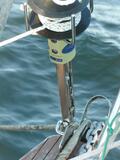
The CDI roller furler may be an outstanding product for its intended use. Our use may be beyond the conditions for which the CDI is intended to be used. We replaced the CDI FF2 that came with the boat with a Profurl R25. The installation was anything but smooth, but once completed, this made a substantial improvement in sail handling in 15 knots or more.
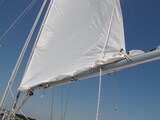
The stock mainsail has four small battens and one reef point. We have put a seconf reef in the mainsail at the end of our second season. We've used the second reef in 25 knots or more and it makes sailing in those conditions quite easy, even with the 110% jib up and furled a bit.
We may in the future replace the mainsail with a full batten mainsail, with at least three reef points and heavier sailcloth in the top portion of the sail. This seems less urgent now that we've been quite satisfied with the sailplan this past season.
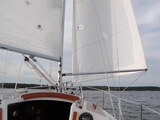
A boom vang and a proper topping lift should be provided by Compac. Some things we've added are:
A mainsheet traveller would be nice. We haven't decided whether to go with mid boom sheeting or end boom with a stainless steel arch.
Self tailing winches might make single handing easier, but represent a significant expense. This improvement doesn't seem necessary.
We now have a Davis Tiller Tamer. I initially wanted to avoid an electronic autopilot due to the current draw. A wind vane steering system, such as Sailomat, is expensive and it is difficult to find room on the transom to mount it. At this point we may get either an autopilot or wind vane steering.
Our goal of comfortable sailing in gail conditions (35-40 knots) will be difficult to acheive. We are now comfortable at 20 knots under full mainsail and full working jib but with excessive weather helm if we are not trimmed just right. With the single reef and the working jib we are very comfortable at 20 knots. With the second reef and a few turns on the roller furler we are quite comfortable at 25 knots. We have yet to test our improved sail inventory in any sustained winds stronger than 25 knots.
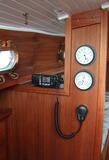
The deck fitting where the bow light was connected had no strain relief and was kicked out within months. We've added an anchor light, masthead fly with a light, and replaced the bow light wiring. We also added a VHF antenna. Compac should at least put some strain relief on their stock wiring. We've redone all of the wiring to provide heftier wiring and grounds and better connections and wire manangement.
Battery charging should be less of a problem now that we have a water towed generator. We need to replace the 6W solar panel with something larger but the mount may cost as least as much as the solar panel(s). I'd like to add two 40W panels.
We have quite a few small loads which add up. We added a fixed mount VHF, an inverter (for occasional use only), a combination knotlog and depth sounder, and a fixed mount GPS. Daytime power draw is still low and have proven within the capability of our small 6 watt solar panel. This small panel is inadequate for even occasional night sailing due to the continuous draw of the navigation lights. The water towed generator should easily handle the navigation lights and instruments on night sails and leave us with a good charge at the end of a night sail.
Prior to installing a charge controller we had some overcharging of the wet cell battery. Unplugging the panel occasionally when the battery voltage exceeds 14V has proven to be a flawed strategy. The wet cell group 27 battery is dead and gone. We now have a AGM group 8D battery giving us 255 AH but weighing 160 lbs. The 6W solar panel seems to do fine with the NCD25A charge controller at keeping a float charge on the battery.
This season we might add an electric autopilot. Because of their continuous use, the fixed mount VHF, instruments, and navigation lights have the greatest impact on electrical charging requirement. An electric autopilot would greatly increase the electrical load.
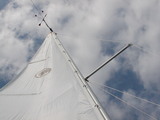
For the most part the Compac 23/3 is well thought out and well laid out. Some small details show a lack of forethought on Compac's part. For example, the outboard handle sticks right into a stern pulpit stancion. It should be easy enough to move these to avoid the location of the outboard mount. There is no good way to store the bimini if you also have a stern pulpit. The bimini track is somewhat in the way of the genoa sheet leads. It should be easy enough do design a bimini frame that fits inside the stern pulpit when foldered down so that it is stored out of the way when not in use.
There are also a few ommissions. A masthead fly is extremely helpful and is very inexpensive. We installed one with a light. This should be standard. I don't see how people sail without one. The only downside is the masthead fly is delicate. Careless handling of the mast can easily smash the masthead fly. I also found out that when stored over the winter a small tree branch carried by the wind can also bend it.
We bought more substantial ground tackle. Anchor storage is an issue. The original hawsepipe is too small for a length of chain. We had to add a second hawsepipe. We may replace the bowsprit with one that can hold our plow anchor on a mid bowsprit roller on one side and hold the mooring line on a separate roller at the end of the bowsprit. The mooring line needs to exit the bow roller forward of where it could chafe on the anchor.
The Compac interior is beautiful. The head placement is inconvenient but typical of a boat this size. A grey water holding tank should be offerred by Compac if they continue to offer a sink. We may move and enclose the head and put in a better galley, but that could be far in the future (or never happen).
The Compac 23/3 as shipped leaves something to be desired when sailing in a strong breeze but many skippers simply won't set sail when a small craft advisory is issued and many small lake sailors seldom see a 20 knots breeze. No production boat of this size is better suited for these stronger conditions than the Compac because of the stability that 1300 pounds of ballast provides even though the sails and other gear are not well suited for more than light weather use.
Before any changes, we could sail in conditions where most other boats of the same size (comparably sized O'Day, Catalina, Precision, Seaward) had long ago headed in. With a smaller headsail and second reef we should be able to sail comfortably in conditions where other boats of this size are no longer at all safe. If Practical Sailor is right, then the standing rigging may not be suited for true offshore use but the stock rig is much stronger than most boats of comparable size and just fine for light coastal cruising.
The boom vang has improved mainsail performance. The boomkicker is a tremendous convenience. The 3:1 outhaul and 3:1 downhaul were good and inexpensive additions. Moving the reefing cleat aft has made it easier to tie in a reef. The second reef give us the confidence that near gale or gale conditions won't overpower the boat, though we have yet to put this to the test at those wind strengths.
For where we sail the 150% genoa was worthless. The CDI furler, though fine for most sailors and priced very competitively, proved inadequate for our use. The 110% working jib is a better primary headsail for the conditions we sail in. The 60% jib gives us a headsail for strong conditions. So far the ProFurl R25 has proven to make raising and lowering sails a lot easier and furls and unfurls very smoothly in any condition we've tried it in.
In a boat this size there is no better designed and built hull for the conditions we want to sail in than the Compac. We're still confident that our Compac was the best new boat on the market for where we sail and our preferences. A Flicka or Cape Dory would be heavier and more solidly constructed but are no longer in production and don't offer the Compac shoal draft of only 27 inches. We've noted Practical Sailor's comments but don't expect to have to change the standing rigging or substantially modify the bulkhead attachment.
In retrospect, we probably should have asked for the boat without sails and spent the extra money to get custom sails in the first place. As is we may end up buying sails twice (buying the stock sails with the boat and then a second set of sails). Getting the CDI roller furler seems to have been a mistake for our use. The CDI is probably fine for most people's use. Compac might want to look into providing a sail track forward of the genoa track, at least as an option, even though it requires different headsails. The strong wind and windward performance improvement was substantial. There are a lot of small additions that have made a difference. The balanced foiled rudder seems like something Compac might want to consider on the stock boat.
The bottom line is we love the boat and made the right choice buying a Compac. We're going to continue to sail her hard and enjoy sailing her to new and more challenging destinations.
A more complete list of completed projects is available. This list contain some additional information, mostly about installation details and in some cases on the parts and equipment used.
A complete list of the modifications planned for Remote Access are on the Prioritized Project List page. These range from immediate projects to very long term projects some of which are not likely to be undertaken.